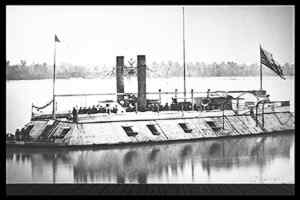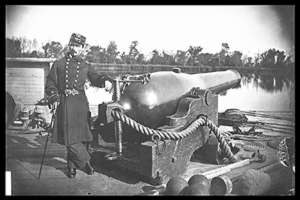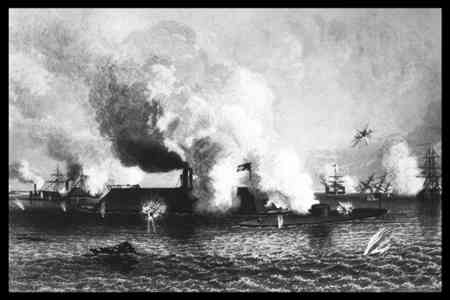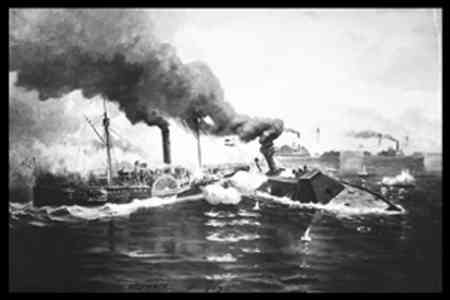Columbus
During the Civil War, Columbus was an important industrial town, second only
to Richmond in the amount of goods it provided to the Confederacy. Located at
the northernmost navigable point on the Chattahoochee River, this prosperous
industrial town of 15,000 at the time of the War had cannon, munitions, and
sword factories; many textile mills which produced uniforms; and the second-largest
iron works in the Confederacy. A 1,500-bed hospital was located here as well.
The energy of falling water powered textile, grist, saw, and paper mills. Its
access to the Gulf through the river and proximity to Deep South cotton plantations,
made Columbus a major railroad and shipping center. When Sherman
marched on Atlanta in 1864, the Atlanta arsenal was moved to Columbus. All these
reasons made Columbus a target of the Union, and on Easter Sunday, April 16,
1865, forces under Gen. James H. Wilson attacked from the west in a rare night
engagement. It was the last significant land battle of the Civil War, occurring
a full week after Lee had surrendered to Grant, and after Lincoln was dead at
an assassin's hands.
Wilson's Raiders were sweeping through the previously untouched industrial belt
of the Deep South, located along the fall line through Alabama and Georgia,
and looking for a place to cross the Chattahoochee. Wilson sent a brigade to
West Point to capture the river crossing there and sent his main force of 11,000
against Columbus. In an engagement lasting a few hours, the town was defended
by a hastily gathered force of less than a few thousand, consisting of old men
and boys, but by 1 a.m. on April 17, the town had fallen, with approximately
a dozen casualties on each side, and 600 Confederate troops escaping toward
Macon, then the capital of Georgia. The next day, Columbus suffered the same
fate as Atlanta six months earlier, when Union troopers burned all the property
of what was considered the last great Confederate storehouse, including more
than 100,000 bales of cotton, the Arsenal, Confederate Naval Iron Works, Confederate
Quartermaster Depot, Haiman Sword factory, 15 locomotives and 200 cars, 5,000
rounds of ammunition and 74 cannon, and the gunboat Jackson, also known
as the Muscogee.
In the 26-block, National Register Historic District of
Columbus, the traveler finds historic homes, cobblestone streets, and many
old brick buildings along the river which  capture
the feel of an antebellum industrial center. On Broadway in the historic District,
Dr. John S. Pemberton, a captain in the Confederate Army and the druggist who
invented Coca-Cola in 1866, operated a pharmacy before the Civil War. His country
home was moved to this district. Many plaques and monuments
around Columbus mark its rich industrial history. The unique Confederate
Naval Museum is a must visit for the Civil War buff,
and the Columbus Museum has excellent displays. The
historic Linwood Cemetery has two Confederate sections, and Fort Benning
has the National Infantry Museum, with many fascinating
exhibits from all American wars, including the Civil War. Columbus was the home
of Gen. Alfred Iverson, Jr., Gen. Henry L. Benning, and Gen. Paul J. Semmes,
two of whom are buried in Linwood Cemetery.
capture
the feel of an antebellum industrial center. On Broadway in the historic District,
Dr. John S. Pemberton, a captain in the Confederate Army and the druggist who
invented Coca-Cola in 1866, operated a pharmacy before the Civil War. His country
home was moved to this district. Many plaques and monuments
around Columbus mark its rich industrial history. The unique Confederate
Naval Museum is a must visit for the Civil War buff,
and the Columbus Museum has excellent displays. The
historic Linwood Cemetery has two Confederate sections, and Fort Benning
has the National Infantry Museum, with many fascinating
exhibits from all American wars, including the Civil War. Columbus was the home
of Gen. Alfred Iverson, Jr., Gen. Henry L. Benning, and Gen. Paul J. Semmes,
two of whom are buried in Linwood Cemetery.
Confederate Naval Museum
202 4th St., Columbus 706-327-9798
The James W. Woodruff, Jr. Confederate Naval Museum
is the national and international clearinghouse of information on the Confederate
Navy, in which was the genesis of  modern
naval warfare. At the start of the Civil War, the South, with few shipyards,
naval engineers, sailors, or heavy industries, had to improvise to compete with
the organized and well-supplied Union Navy.
modern
naval warfare. At the start of the Civil War, the South, with few shipyards,
naval engineers, sailors, or heavy industries, had to improvise to compete with
the organized and well-supplied Union Navy.
Museum displays illustrate the development and operation of the naval mine,
submarine, and battleship, all of which trace their first practical deployment
to the Confederate Navy. Two exterior exhibits display the salvaged remains
of two entirely different Confederate warships: The 225-foot long ironclad ram
C.S.S. Jackson, and the 130-foot long steam/sail powered gunboat C.S.S.
Chattahoochee. Both were sunk in the Chattahoochee River near the War's
end. The Chattahoochee, built in 1861-62 at Saffold, Early County, Georgia,
was first captained by Cmdr. Catesby ap R. Jones, who is famous for commanding
the C.S.S. Virginia, known as the Merrimack, during its famous
duel with the U.S.S. Monitor, known as the first battle between ironclad
warships and the beginning of modern naval warfare. The Chattahoochee
operated on the upper Appalachicola until it suffered a boiler explosion and
sunk on May 27, 1863, near Blountstown, Florida. Those killed were buried in
Linwood Cemetery in Columbus. The Chattahoochee was raised and taken
to Columbus for repairs, and later scuttled on April 16, 1865 to prevent capture
by Union forces under Gen. James H. Wilson. The Jackson was built in
Columbus, but after the center paddlewheel-powered ironclad's failed launch
in early 1864, the vessel was redesigned to a twin-screw arrangement and relaunched
on Dec. 22, 1864. The powerful Jackson featured 4-inch thick iron plating
backed by two feet of wood, with six large Brooke rifles. Shortly before the
ship was finished, it was captured in Columbus by Wilson's Raiders, torched
and set adrift, where it floated 30 miles downstream before beaching on a sandbar
and burning to the waterline. Both the Jackson and the Chattahoochee
were salvaged in the early 1960s.
- Columbus-Manchester Rd. becomes 4th Ave. Travel on 4th Ave. until
it deadends into 4th St. Turn right on 4th st. and find the museum on the
left.
 Columbus
Naval Iron Works
Columbus
Naval Iron Works
801 Front Avenue, Columbus 706-327-4522
Built in 1853, originally the Columbus Iron Works and then Confederate Naval
Iron Works, this factory was the second largest iron producer in the Confederacy.
This factory supplied steam engines, iron cladding, and other parts to all the
Confederate shipyards in the South, along with cannon and a wide variety of
cast iron products. Today, the restored building, with its old brick walls and
huge timbers representing the best of 19th century craftsmanship, is on the
National Register of Historic Places and serves as Columbus' convention center,
named the Columbus Iron Works Convention & Trade Center. The building is
open to the public and has exhibits of machinery, products, casting and armor
from the C.S.S. Chattahoochee and C.S.S. Jackson, and the "Ladies
Defender," a cannon manufactured from brass cooking utensils donated by
the ladies of Columbus.
- I-185 to exit 7A/B. Travel on the Columbus-Manchester Exp./Alt. 27
into the historic district. Front Ave. faces the Chattahoochee River.
Linwood Cemetery
Linwood Blvd. west of 10th Ave., Columbus
Linwood Cemetery has two Confederate sections —
Naval and Army — with the graves of more than 200 soldiers from the Civil
War, many of whom died in the several Confederate hospitals located in Columbus
from 1862-65. Some buried in the cemetery are casualties from the Battle of
Columbus. Others died in a boiler explosion on the C.S.S. Chattahoochee
and are buried in the Naval Section, with their graves guarded by one
of the rifled guns from the Ironclad Jackson. Maj. Gen.
Paul Jones Semmes, a Columbus banker and planter who won glory fighting
in the Eastern Theater with Gen. Robert E. Lee, died from a wound to the thigh
suffered at Gettysburg while leading his men across "the wheat-field"
and is buried here. So is Brig. Gen. Henry L. "The Rock"
Benning, a Columbus lawyer and politician who gained respect from his troops
for his coolness and bravery during many battles in the Eastern Theater throughout
the Civil War. Fort Benning is named for him. Also buried in the cemetery is
Brig. Gen. Pleasant J. Philips, who commanded
troops at the battle of Griswoldville, Georgia, one of the few actions opposing
Union Gen. W.T. Sherman's
"March to the Sea."
National Infantry Museum
Building 396, Baltzell Ave., Ft. Benning 706-545-2958
The National Infantry Museum is considered the finest
military museum in the country and is one of the larger museums in the state,
displaying more than two centuries worth of artifacts in 30,000 feet of exhibit
space on three floors. Its collections run from the 1600s to the present day.
From the Civil War, the museum has on display Gen. Ulysses S. Grant's traveling
liquor cabinet, Union and Confederate uniforms, a set of Civil War dominoes,
playing cards, a painted eagle drum, bugle numerous Confederate flags, a re-creation
of Confederate Gen. Henry L. Benning's drawing room, a rare regimental flag
from the Union's 2nd Regiment of Colored Troops, and more.
- Victory Dr. south to Ft. Benning Rd.
Columbus Museum
1251 Wynnton Rd., Columbus 706-649-0713
The museum, with its focus on the Chattahoochee River
Valley, has many fine exhibits, including one on the significance of the Civil
War in Columbus history and a collection of Confederate and Union weapons.
- Tenth Ave. to Wynnton Rd. Travel east. Museum will be on the left.
Reader-Contributed Links to the Civil War in Georgia Book:
 capture
the feel of an antebellum industrial center. On Broadway in the historic District,
Dr. John S. Pemberton, a captain in the Confederate Army and the druggist who
invented Coca-Cola in 1866, operated a pharmacy before the Civil War. His country
home was moved to this district. Many plaques and monuments
around Columbus mark its rich industrial history. The unique Confederate
Naval Museum is a must visit for the Civil War buff,
and the Columbus Museum has excellent displays. The
historic Linwood Cemetery has two Confederate sections, and Fort Benning
has the National Infantry Museum, with many fascinating
exhibits from all American wars, including the Civil War. Columbus was the home
of Gen. Alfred Iverson, Jr., Gen. Henry L. Benning, and Gen. Paul J. Semmes,
two of whom are buried in Linwood Cemetery.
capture
the feel of an antebellum industrial center. On Broadway in the historic District,
Dr. John S. Pemberton, a captain in the Confederate Army and the druggist who
invented Coca-Cola in 1866, operated a pharmacy before the Civil War. His country
home was moved to this district. Many plaques and monuments
around Columbus mark its rich industrial history. The unique Confederate
Naval Museum is a must visit for the Civil War buff,
and the Columbus Museum has excellent displays. The
historic Linwood Cemetery has two Confederate sections, and Fort Benning
has the National Infantry Museum, with many fascinating
exhibits from all American wars, including the Civil War. Columbus was the home
of Gen. Alfred Iverson, Jr., Gen. Henry L. Benning, and Gen. Paul J. Semmes,
two of whom are buried in Linwood Cemetery.
 modern
naval warfare. At the start of the Civil War, the South, with few shipyards,
naval engineers, sailors, or heavy industries, had to improvise to compete with
the organized and well-supplied Union Navy.
modern
naval warfare. At the start of the Civil War, the South, with few shipyards,
naval engineers, sailors, or heavy industries, had to improvise to compete with
the organized and well-supplied Union Navy.
 Columbus
Naval Iron Works
Columbus
Naval Iron Works 